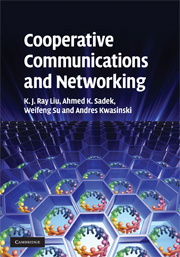Book contents
- Frontmatter
- Contents
- Preface
- Part I Background and MIMO systems
- Part II Cooperative communications
- Part III Cooperative networking
- 11 Cognitive multiple access via cooperation
- 12 Content-aware cooperative multiple access
- 13 Distributed cooperative routing
- 14 Source–channel coding with cooperation
- 15 Asymptotic performance of distortion exponents
- 16 Coverage expansion with cooperation
- 17 Broadband cooperative communications
- 18 Network lifetime maximization via cooperation
- References
- Index
16 - Coverage expansion with cooperation
from Part III - Cooperative networking
Published online by Cambridge University Press: 06 July 2010
- Frontmatter
- Contents
- Preface
- Part I Background and MIMO systems
- Part II Cooperative communications
- Part III Cooperative networking
- 11 Cognitive multiple access via cooperation
- 12 Content-aware cooperative multiple access
- 13 Distributed cooperative routing
- 14 Source–channel coding with cooperation
- 15 Asymptotic performance of distortion exponents
- 16 Coverage expansion with cooperation
- 17 Broadband cooperative communications
- 18 Network lifetime maximization via cooperation
- References
- Index
Summary
For practical implementation of cooperative communications in wireless networks, we need to develop protocols by which nodes are assigned to cooperate with each other. In most of the previous chapters on cooperation, the cooperating relays are assumed to exist and are already paired with the source nodes in the network. A deterministic network topology, i.e., deterministic channel gain variances between different nodes in the network, was also assumed. If the random users' spatial distribution, and the associated propagation path losses between different nodes in the network, are taken into consideration, then these assumptions, in general, are no longer valid.
Moreover, it is of great importance for service providers to improve the coverage area in wireless networks without the cost of more infrastructure and under the same quality of service requirements. This poses challenges for deployment of wireless networks because of the difficult and unpredictable nature of wireless channels.
In this chapter, we address the relay assignment problem for implementing cooperative diversity protocols to extend the coverage area in wireless networks. We study the problem under the knowledge of the users’ spatial distribution which determines the channel statistics, as the variance of the channel gain between any two nodes is a function of the distance between these two nodes. We consider an uplink scenario where a set of users are trying to communicate to a base station (BS) or access point (AP) and describe practical algorithms for relay assignment.
- Type
- Chapter
- Information
- Cooperative Communications and Networking , pp. 550 - 568Publisher: Cambridge University PressPrint publication year: 2008



